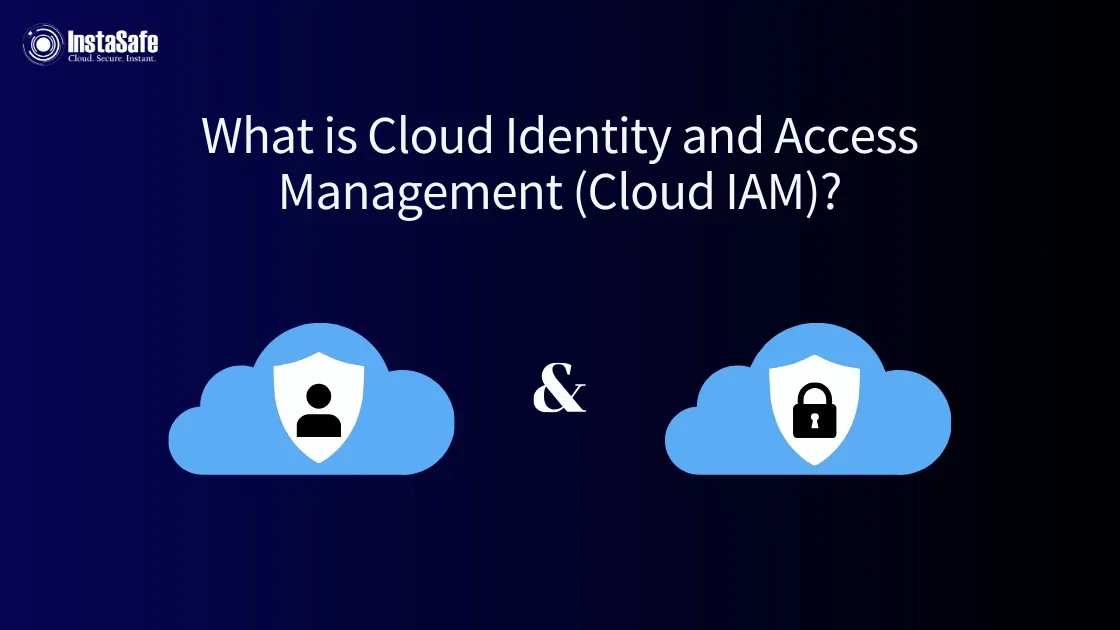What is Cloud Identity and Access Management (Cloud IAM)?

Organisations need to protect their valuable resources while still allowing the right people to access them. Cloud identity and access management (Cloud IAM) serve as the virtual security guard for these digital resources, making sure only authorised individuals can get in.
What is Cloud Identity and Access Management (Cloud IAM)?
Cloud IAM is a security infrastructure that is deployed in the cloud to assist organisations in verifying user identities and regulating the content they can access. Think of it as a sophisticated doorman for your digital assets - checking IDs, determining who gets access to which rooms and keeping track of who goes where.
The core function of cloud identity and access management is to ensure that the right people have access to the right resources and nothing else. This security approach operates on the principle of "least privilege," meaning users only get access to what they absolutely need to do their jobs.
IAM cloud security has become increasingly important as organisations move their operations to the cloud. With data and applications stored across multiple cloud platforms, traditional security methods that rely on physical network boundaries are no longer sufficient.
How Cloud Identity and Access Management Works?
Authentication
Authentication makes sure that people are who they say they are. This process involves checking credentials like:
- Passwords (something you know)
- Biometrics like fingerprints (something you are)
- Security tokens or smartphone apps (something you have)
Multi-factor authentication (MFA) improves security by integrating two or more of these verification methods. For instance, you may receive a one-time code on your phone that you must also input after entering a password.
Access Control
Once a user's identity is verified, access management determines what resources they can use. This involves:
- Role-based Access: Permissions based on job functions.
- Attribute-based Access: Permissions based on user attributes like department or location.
- Context-based Access: Permissions that consider factors like time of day or device used.
Directory Services
Directory services store user identity information and their assigned permissions. These databases serve as the central repository of who can access what within the organisation.
Policy Enforcement
Policies are the rules that determine access privileges. Cloud identity management solutions automatically enforce these policies across all connected systems and applications.
Benefits of Cloud IAM
Enhanced Security
By requiring proper authentication and limiting access privileges, IAM cloud security significantly reduces the risk of data breaches. According to research, stolen credentials are one of the most common attack vectors for cybercriminals. Cloud IAM systems help neutralise this threat by requiring additional verification beyond just passwords.
Simplified User Experience
Single sign-on systems enable users to authenticate themselves once and gain access to different applications and resources. This eliminates the frustration of remembering numerous passwords and reduces time wasted on multiple logins throughout the day.
Reduced IT Burden
Password reset requests can consume significant IT help desk resources. Cloud IAM reduces these costs by minimising password-related issues.
Improved Compliance
Cloud identity and access management helps organisations meet regulatory requirements like GDPR, HIPAA and PSD2 by:
- Controlling who can access sensitive data
- Providing audit trails of access attempts
- Enforcing data privacy controls
Scalability and Flexibility
Cloud IAM solutions easily scale to accommodate growth. Whether onboarding hundreds of new employees or managing millions of customer identities, cloud-based systems adapt without requiring significant infrastructure investments.
Cost Efficiency
Moving identity management to the cloud reduces infrastructure costs associated with on-premises solutions. Organisations avoid expenses related to hardware, maintenance and specialised personnel.
Cloud IAM Vs Traditional IAM
Traditional identity management systems were primarily designed for on-premises environments where resources existed within a defined network perimeter. Cloud identity management solutions differ in several important ways:
Deployment Model
Traditional IAM: Installed on physical servers within an organisation's data centre.
Cloud IAM: Delivered as a service through the cloud.
Access Scope
Traditional IAM: Primarily focused on internal network resources.
Cloud IAM: Secures access across multiple environments (cloud, on-premises, hybrid).
Management Approach
Traditional IAM: Often requires manual configuration and updates.
Cloud IAM: Provides automated provisioning and policy enforcement.
Scalability
Traditional IAM: Limited by physical infrastructure capacity.
Cloud IAM: Easily scales up or down based on organisational needs.
Essential Features of Cloud IAM
Single Sign-On (SSO)
It allows legitimate users to log in only once and then use their passwords to access multiple apps without having to enter them again. This makes things easier for users while still keeping them safe.
Multi-Factor Authentication (MFA)
Before granting access, MFA requires completing multiple forms of verification, which decreases the possibility of unauthorised access, even in the event that passwords are compromised.
Automated Provisioning and Deprovisioning
Cloud identity management solutions can automatically grant or revoke access when employees join, change roles or leave an organisation, ensuring proper access control at all times.
Adaptive Authentication
This risk-based approach adjusts authentication requirements based on factors like location, device and behaviour patterns. A login attempt from an unusual location might trigger additional verification steps.
Self-Service Capabilities
Self-service features allow users to reset passwords or request access without IT intervention, reducing administrative burden while maintaining security controls.
Auditing and Reporting
Comprehensive logging and reporting tools help organisations monitor access patterns, identify potential security issues and demonstrate compliance with regulations.
Cloud IAM in Different Environments
Public Cloud
Public cloud providers like AWS, Microsoft Azure and Google Cloud Platform offer built-in IAM capabilities for resources hosted on their platforms. These native tools provide basic identity management but may require additional solutions for cross-cloud security.
Private Cloud
Organisations running private clouds can implement Cloud IAM solutions specifically designed for their environment, providing tight control over authentication and access management.
Hybrid Cloud
For businesses with both on-premises and cloud resources, hybrid Cloud IAM solutions provide unified identity management across all environments, ensuring consistent security policies.
Multi-Cloud
Companies using multiple cloud providers can implement Cloud IAM that works across different platforms, providing centralised control over identities and access regardless of where resources reside.
4 Stages of Implementing Cloud IAM
1. Assessment Phase
Begin by understanding your organisation's specific needs:
- Inventory all applications and resources requiring protection.
- Identify user groups and their access requirements.
- Document current authentication and access control processes.
2. Selection Phase
Choose appropriate Cloud IAM solutions based on the following:
- Support for required authentication methods.
- Integration capabilities with existing systems.
- Scalability to meet future needs.
- Compliance with relevant regulations.
3. Implementation Phase
Roll out your selected solution with these best practices:
- Start with a pilot group before full deployment.
- Configure role-based access controls aligned with the organisational structure.
- Implement strong authentication policies.
- Integrate with existing directory services.
4. Maintenance Phase
Continuously improve your IAM cloud security by:
- Regularly reviewing and updating access policies.
- Monitoring for unusual access patterns.
- Auditing user privileges to prevent permission creep.
- Training users on security best practices.
Challenges of Cloud IAM
While Cloud IAM solutions offer significant benefits, organisations may face several challenges:
Integration Complexity
Connecting Cloud IAM with legacy systems and diverse cloud services can be technically challenging, requiring careful planning and possibly custom integration work.
User Resistance
Employees might resist additional authentication steps or new access procedures, perceiving them as barriers to productivity rather than security enhancements.
Identity Sprawl
As organisations adopt more cloud services, managing identities across multiple platforms becomes increasingly complex without a unified approach.
Compliance Requirements
Different industries and regions have specific regulatory requirements for identity management, requiring careful configuration of Cloud IAM solutions to ensure compliance.
The Future of Cloud IAM
Passwordless Authentication
Many Cloud IAM solutions are moving toward passwordless approaches using biometrics, hardware tokens, or cryptographic keys, eliminating the security risks associated with passwords.
Artificial Intelligence
AI and machine learning are enhancing IAM cloud security by detecting unusual access patterns and potential security threats based on behavioural analysis.
Zero Trust Architecture
The zero trust model, which assumes no user or system is inherently trustworthy, is becoming integrated with Cloud IAM, requiring continuous verification regardless of location or network.
Blockchain-Based Identity
Some innovative Cloud identity management solutions are exploring blockchain technology to create secure, decentralised identity systems that give users more control over their digital identities.
Conclusion
Cloud identity and access management (Cloud IAM) have become essential for organisations navigating the complex landscape. By ensuring that only the right users can access specific resources, Cloud IAM solutions protect valuable data while enabling productivity across increasingly distributed workforces.
InstaSafe Cloud Access Security simplifies multi-cloud security with our powerful Zero Trust solution. We protect your digital assets through risk-based authentication and role-based controls, giving you single-click access to all cloud applications.
Also, we reduce operational costs while maintaining complete visibility through our single management console. Choose InstaSafe to secure your cloud journey with confidence!
Frequently Asked Questions (FAQs)
- What are the primary security risks if Cloud IAM is not properly implemented?
Improper Cloud IAM implementation can lead to unauthorised access, data breaches, privilege escalation and compliance violations across cloud environments.
- How do small businesses benefit from Cloud IAM solutions compared to enterprises?
Small businesses gain enterprise-level security without extensive infrastructure investments, reducing technical debt while achieving compliance requirements with minimal IT staff.
- What should organisations consider when migrating from traditional IAM to Cloud IAM?
Organisations should assess identity lifecycle management processes, plan for hybrid transition periods, and evaluate vendor lock-in risks when migrating to IAM cloud security.
